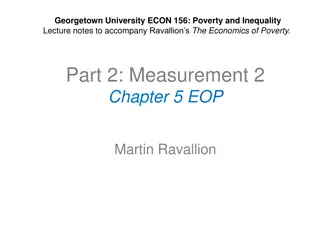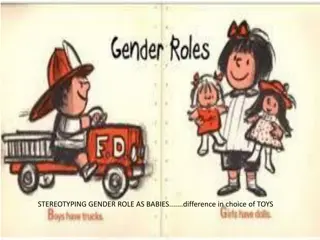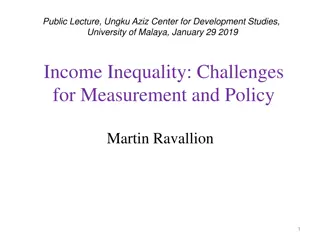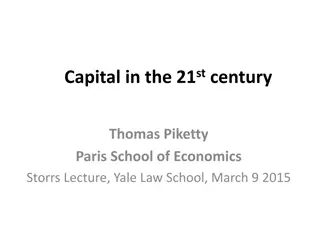Gender Inequality and Macroeconomic Policy
Exploring the differential impacts of macroeconomic structures and policies on gender equality, this analysis delves into issues such as gender-biased access to resources, labor-intensive export orientation, and the effects of inflation targeting. It highlights how women, especially in marginalized groups, bear a disproportionate burden in both developed and developing economies due to neoliberal macro policies and gender segregation. The study underscores the importance of addressing gender disparities in economic policymaking to achieve sustainable and inclusive growth.
Download Presentation

Please find below an Image/Link to download the presentation.
The content on the website is provided AS IS for your information and personal use only. It may not be sold, licensed, or shared on other websites without obtaining consent from the author. Download presentation by click this link. If you encounter any issues during the download, it is possible that the publisher has removed the file from their server.
E N D
Presentation Transcript
Macro Policy for Gender Equality Elissa Braunstein Professor & Chair, Department of Economics Colorado State University Editor, Feminist Economics
Feminist Macroeconomics Macroeconomy 2. Structure & performance of the economy Gender inequality and growth Gender-biased access to credit, land & agricultural inputs aggregate productivity 1. Differential impact of macro structure & policy Labor-intensive export orientation women s employment Impacts of austerity 3. Accounting for care and social reproduction Gender equality & gendered well- being
Differential impact of macro structure and policy: Employment and inflation reduction Differential effects of formal and informal inflation-targetting by gender, race & ethnicity Developing and emerging economies Inflation reduction overwhelmingly contractionary Women s employment suffers more than men s Most IREs associated with higher real interest rates, but when they are accompanied by higher real exchange rates, women s employment suffers much than men s Developed economies US: Ethnic minorities, less educated and less skilled see greater employment losses with higher interest rates Work on gender is less conclusive, but insufficient accounting for inter-group inequality Subordinate groups shoulder a disproportionate share of the costs of inflation-targetting
Differential impact of macro structure and policy: Gender segregation and neoliberal macro policy Some context Inclusion and markets among the IFIs Expanding the scope of markets as a way to address the challenges of modern capitalism Supply side problems: Marginalized people lack the assets/skills/information to participate Gender equality and work agenda Political economy of exclusion Evolution of global capitalism Rising inequality and good job scarcity grafted onto gender
Changes in women/men employment versus mens employment rates, 1991 to 2014 (percentage points) 30 30 Change in women/men employment rate Change in women/men employment rate Gender conflictual? Gender conflictual? 20 20 64.7% 33.3% 56.3% 55.0% 44.1% 77.3% 10 10 0 0 -10 -10 -30 -20 -10 0 10 20 -30 -20 -10 0 10 20 Change in men's employment rate Change in men's employment rate Developed countries Transition countries Developing countries Africa Asia America Our econometric analysis shows that: Lower availability of good jobs in global labor markets Increased gender segregation, with women more concentrated in bad jobs Gender segregation strongly associated with neoliberal macro policy (trade, fiscal, capital account openness) Due to declining number of good jobs, women s increased employment has led to their integration on inferior terms. What progress we have seen in increased relative employment for women is thus gender conflictive.
Gender Structure and performance of the macroeconomy: Gender stratification in labor markets Concentration of women in export-oriented sectors Feminization of foreign exchange earnings Lever for maintaining lower real exchange rates Political economy of central bank policy Wage compression enables sacrifice ratios to be higher for some, politically less powerful, groups than others. Finance-friendly monetary policy less politically costly Gender segregation lower bargaining power for labor lower labor share of income Increased gender segregation between 1990 and 2014 associated 4.7% decline in the labor share.
Structure and performance of the macroeconomy: Macro policy and social reproduction Social reproduction The time and commodities it takes to maintain, invest in, and reproduce the labor force Economic growth models do not treat labor as produced or maintained Long-run versus short-run
Modeling the macroeconomy and social reproduction: The demand side Gender equality in the labor market Growth Depends on the impacts on production and profitability
The Demand Side: Economic Growth Stylized types of economies Care-led Inequality-led Relationship between gender equality in the labor market & growth Positive Negative Gender equality in the labor market Growth Characteristics Depends on the impacts on production and profitability
The Demand Side: Economic Growth Stylized types of economies Wage- or Care-led Inequality-led Relationship between gender equality in the labor market & growth Positive Negative Gender equality in the labor market Growth Characteristics Caring spirits Strong Weak Depends on the impacts on production and profitability Caring spirits: the tendency, whether determined by social norms, individual motivation, or public preferences as reflected in the structure of the social welfare state, to provide care (or support for care) for one s self and others in ways that add to current production and future economic productivity.
The Demand Side: Economic Growth Stylized types of economies Wage- or Care-led Inequality-led Relationship between gender equality in the labor market & growth Positive Negative Gender equality in the labor market Growth Characteristics Caring spirits Strong Weak Developmental, employment- oriented Geared to managing financial openness Depends on the impacts on production and profitability Macro policy stance Caring spirits: the tendency, whether determined by social norms, individual motivation, or public preferences as reflected in the structure of the social welfare state, to provide care (or support for care) for one s self and others in ways that add to current production and future economic productivity.
Growth & Social Reproduction Supply: Distribution of social reproduction Demand: Growth Low-road: High-road: Gender egalitarian Feminization of responsibility and obligation Time squeeze Higher wages for women are good for growth, but more market participation squeezes time and lowers human capacities production. Growth is elusive or unstable. Mutual Higher wages for women are good for growth, and more market participation increases human capacities production. Growth and social reproduction reinforce one another. Care-led: Strong caring spirits Exploitation Higher wages for women lower growth, and more market participation squeezes time and lowers human capacities production. Growth is partly based on exploiting women s labor and human resources. Wage squeeze Higher wages for women lower growth, but more market participation enhances human capacities production. Growth is elusive or unstable. Inequality-led: Weak caring spirits & neoliberal macro polilcy
Empirical estimation: Time paths of social reproduction regimes, 1990-2015
A review of macro policy for gender equality Macroeconomy 2. Structure & performance of the economy Gender & export performance Employment costs of inflation reduction Gender segregation and the labor share of income 1. Differential impact of macro structure & policy Employment & inflation reduction Gender segregation and women s access to good jobs 3. Accounting for care and social reproduction Gender equality & gendered well- being























